
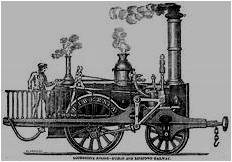
It was noisy, it was smoky, it was accident prone (the track from Terenure to Blessington was known as “The Longest Graveyard in Ireland), it was often late, it was often derailed, the rate payers along the route were tired subsidising it. Yet people were sorry to see it go and memories about it still linger in the West Wicklow and South County Dublin areas.
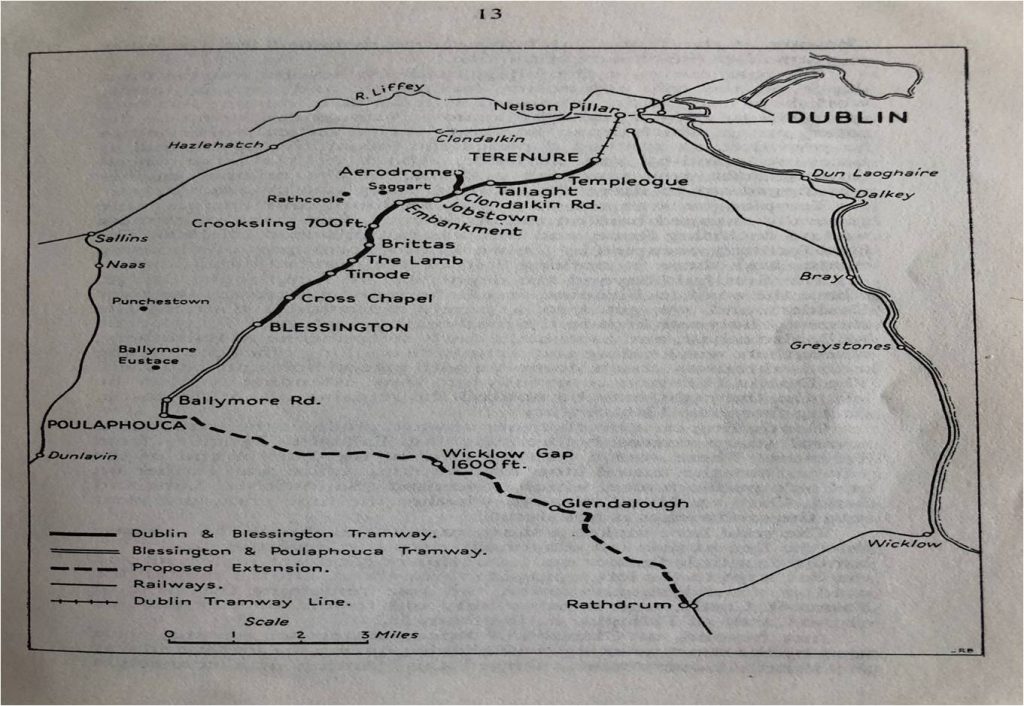
We can see from this map that the east of our county was served well by the Dublin/Wicklow/Wexford Railway. As, indeed, was the western fringe by a railway from Dublin to Sallins, Harristown, Dunlavin and Baltinglass. Until well into the 1800’s we in West Wicklow were relying on an outdated system of horse-drawn coaches. In the spirit of the times the British Parliament, from 1860 onwards, passed laws enabling light railways to be built in Ireland. They would be built on the side of the road. They would be relatively inexpensive; would not need bridges, tunnels, or crossings. Small plots of land would have to be bought where there were sharp bends. They would be appropriate for short distances. Many would be constructed from 1880 onwards for instance the Sutton Line to the Hill of Howth, that from Conyngham Road to Lucan and , of course, the West Clare Railway, made famous by Percy French and his “Are ye right there Michael?” parody.
By order of the Lord Lieutenant (Earl Spencer) and the Privy Council permission was granted to John Alexander Walker and William Elliot O’Donnell to construct and maintain a tramway between Dublin and Blessington. These two Promoters formed a joint Stock Company to raise the necessary funds. The Chairman was to be the Earl of Milltown. The Directors were to be the following : William Owen ( Downshire agent), Fletcher Moore (Manor Kilbride), Thomas H. Guinness, William Domville Handcock and John Alexander Walker.
Shares
Guaranteed Shares of £10 each for £40,000 , Interest of 5% to be guaranteed by Wicklow and Dublin Baronies in the event of closure. The ledger records of the purchasers of these shares make for very interesting reading indeed . Railways were seen as up and coming investments and wealthy people took their chance. The premier addresses of the investors tell their own story. Ordinary Shares at £10 each were to raise £57,000.

Later on Poulaphouca Extension £5 shares raised £20,000. Alexander Ward was given the contract to build the Tramway to Blessington. The contract price was £89,400 and was to include all expenses. Ward already had the experience of building the Lucan Tramway. He subcontracted the provision of rolling stock and equipment to Martin Mac Donnell of Dunmore, Co. Galway for the sum of £8,000. The contract with Ward included a schedule of materials to be used and how the work was to be done. Some interesting data from this schedule are detailed, for instance the sleepers were to be 9 feet long by 9 inches by 4 and a half inches, to be creosoted and of native larch or Baltic red wood, and free from bad knots or shakes. The rails were to be not less than 18 feet in length and have marked on them the makers name, year of manufacture, and the initials D & B T (Dublin & Blessington Tramway) . Fortunately we have some old rails, spikes and a sleeper still in existence in Blessington. Earthworks or embankments were needed in some places and one such at the bottom of Crooksling Hill is still so known as “The Embankment.” Later on Alexander Ward, on his own behalf, built the Station House at Poulaphouca which he leased to the Company.

Everything was eventually ready and the first train the 8.35 a.m. ran from Terenure to Blessington. The tramway connected with horse drawn trams from Nelson’s Pillar. To mark the occasion a special coach was laid on from the Pillar carrying the mail, the Company Directors and other V.I.P’s. The above photograph shows the entourage on their way. The group carried on to Blessington. There was great excitement along the way. The wonder was how this new contraption didn’t fall off those slender rails. (In fact it often did over the years). The tram held a fascination for people as long as it ran. Even afterwards memories of a gallant noisy smoky little engine drawing double deck carriages long after it stayed in people’s minds. The tram’s arrival in Blessington was a sensation with young and old cheering and waving to the rafters. The new service would be a great boon to the whole area. Children and indeed young and old would want a spin in this new wonder amongst them. It was great.
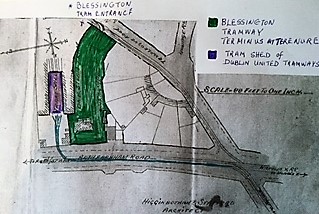
Green shows Blessington Tramway end from Templeogue Rd., side by side with the purple Dublin United Tramways site from Rathfarnam Rd.
What was carried by the Tram? Passengers, livestock (cattle, sheep and yes , rabbits. From Ulster Bank Blessington consignments of rabbits were regularly sent to the Bradford Small Animal Show in England), sand, gravel, stone, mail, newspapers and general merchandise. There was an agreement with Tom Hudson of Crooksling to carry army supplies and equipment to and from Kilbride Camp at Shankill. As his deliveries were done by horse and cart over a hilly area the question arises as to what route he would have taken.
Accidents
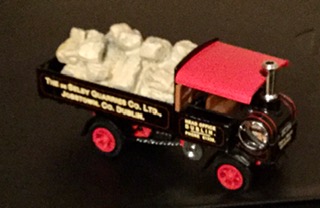
One of the many accidents, Tram v Wallace’s Steam Wagon 18th July 1930 : The conductor on the day, John Jones, gave his side of the story as follows: “I beg to report that while working the 2.35 p. m. down on Wednesday the 16th inst. , when approaching Lisheen Rd. I had just taken a fare and was about to sit down two seats from the front of the car, when I was violently thrown forward against the front of the car, and sustained factures to my left arm and ribs for which I had to be treated in hospital. I found that a steam wagon the property of Wallace Bros. coal merchants had struck the car and had badly damaged it. The driver of the steam wagon gave his name as Robert Mosley 15 Bath Ave., Sandymount. There were no passengers on the car except a child who had boarded the car at Brittas. The number of the steam wagon was ‘A.W. 7428.’
There were many fatalities on the line. One particularly sad case was the death of Conductor John Jones of Templeogue and father of five, when he was accidently thrown from the tram. This fatality occurred on the night of September 30th 1931. He had not been on duty as a conductor and was not covered by the Tram Company’s insurers, The Ocean Corporation. This put his wife and five children (between 16 and 2) in a most harrowing situation. Adding to the calamity was that his wife was a patient in Harold’s Cross Hospice dying of consumption. When she heard of her husband’s death she left it to be with her children. She passed away not long after that. The children were now orphans. The only income the family had was from the 16 year old eldest daughter who earned a little in Urney’s Chocolate Factory. The next daughter was lodged with the Sisters in Golden Bridge Orphanage. Two children were taken in by relations but one ended up in the Hospice where her poor mother had been. Fr Sheehan P.P. Terenure wrote to the Tram Committee pleading for some help for the destitute family. The reply was that the Company had no responsibility in the matter. But while they did not accept legal commitment they were eventually willing to make an “ex gratia” contribution of £25 in the terrible circumstances. 25 Subscription Cards were printed in which John’s brother Peter Jones of Carlow was involved. Including the £25 from the Tram Company £74- 1-8 was raised for the dependents. Through Fr Sheehan and the St Vincent de Paul Society £70-8-0 was invested for them, the certificates being sent to Peter Jones of Carlow for safekeeping. The amount of £3-13-8 left over was sent to the Superioress of the Harold’s Cross Hospice towards the care of the sick child.
Fr Brown’s Tram trip 1920
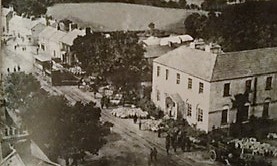
Fr. Maurice Brown took up ministry as curate of Monavalla (nowadays known as Valleymount) on September 8th 1920. He arrived at Terenure terminus for the 7.30 a.m. tram to Blessington and Poulaphouca. He describes his trip as far as Featherbed Lane opposite Russborough House. “Are people still often killed?” Fr Brown queried. The tongue in cheek reply was “No, Father, only once.” While the steam-tram moved slowly into Blessington the jobbers had their faces glued to the windows, looking at the sheep that were grouped at close intervals on the outskirts of the town, each flock controlled by a little black-and-white collie. In the long street there was great bustle; horses trotted up and down under the close scrutiny of dealers; cattle were being vetted; prospective buyers were poking their sticks at the pigs in creels; and bargains were struck on open palms. A stray sheep was being pursued by a long lanky man in a frieze coat as it jumped over car shafts and barrels. Sheep bleated, horses neighed, cattle lowed, pigs squealed, dogs barked. Fr. Brown had seen the New York Grand Central Station in rush-hour but it was only in the half-penny place beside the square in Blessington on a fair day. Andy, the conductor, was proud to observe that a stranger should be so impressed. “Nearly all the sheep men are your parishioners”, he said. Fr. Brown liked the look of the men from the hills.
Extracts from Minute Books.
1893: Osborne & Brady-100 tons of granite to Terenure at 2/- per ton. Drivers given reward for low consumption of coal. Guards report passenger J. Booth refused to pay one penny fare. Summons that man !! Fined 10/- plus costs plus one penny. 1895: Osborne & Brady install granite stone lettered D&B and P&B at Blessington. The cost was £2-5-0. Driver McMahon sent to trial for death of child. Advised by Company to plead guilty to save further litigation. Pay £5 to parents. 1902: Driver Brazil seeks increase in pay. Two pence a week granted. Oxley will not accept anything less than £100, his costs and a wooden leg, by way of compensation. He had been a chauffeur when struck by Tram. M. Ryan applying for pay during absence owing to being crushed between wagons. Half pay granted. For being ‘under the influence’ Mackey was cautioned and advised to take the pledge. Letter from the National Association for Prevention of Tuberculosis, asking that notices against spitting, be put up in cars and floors sprinkled with disinfectant. John Reilly of Baltiboys killed by 8.35 p.m. down near Brittas Ponds. Horse belonging to P. Lawlor of Balrothery killed by Tram. Lawlor prosecuted and fined 10/6 or 2 weeks. Inquest on J. Preston who had been crushed by a wagon at Brittas.
The ‘Cambria’ Locomotive feeling her age.
Thank God for this stop at Embankment
The water here’s pristine and clear.
A shilling a year and well worth it
A good swallow indeed for the mountain.
Me stomach is belching – no wonder.
This work it just pulls you asunder.
Cheap coal from our Cambrian neighbour
Sure its far worse than doin’ hard labour.
Half way up the long hill we get stranded.
The ice on the rails means no traction.
“Hould her steady”, says Matt the conductor
“We’ll get out and we’ll give her a push”.
We make it as far as Tom Hudson’s.
With the slope I can now draw me breath.
We view the Mill Ponds on our left
And soon pull into Dowling’s at Brittas.
I’m left all alone for five minutes
While Matt and his pal driver Tom
Replenish themselves in the snug-bar
And emerge with a smile and a chuckle.
Baile Coimin now hoves into view.
A fair day with some wonderful clatter. . Sheep and horses and cattle and pigs …All the shouts slappin’ hands and divarsion.
The faction fights in Ireland . . Were common long ago, . But once again behold two stalwarts brave and true, . . . Throw fists in gay abandon.
More drink for the thirsty pretenders. . . I’ll be luggin’ cattle wagons tonight. . . But now a free wheel to the Falls.
I suppose life could be worse after all.
I feel pains comin’ on me auld bones.
Its arthritis and a touch of lumbago.
I’m goin’ to need care and attention At Templeogue Depot tomorrow.
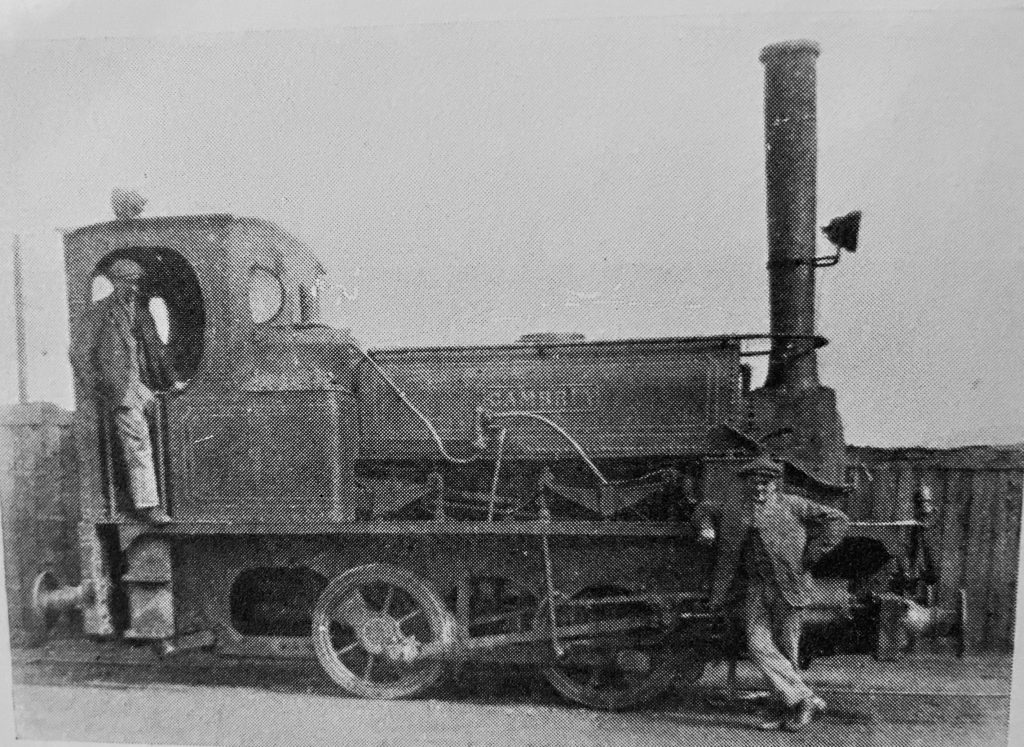
They said I was no longer much use – that it was time I retired. Then they hauled me over here to Hammond Lane. First they ripped me apart and bit by bit melted me down in their hell hole of a foundry. Now I’m all over the place – I don’t know where I am. Ochon agus ochon!
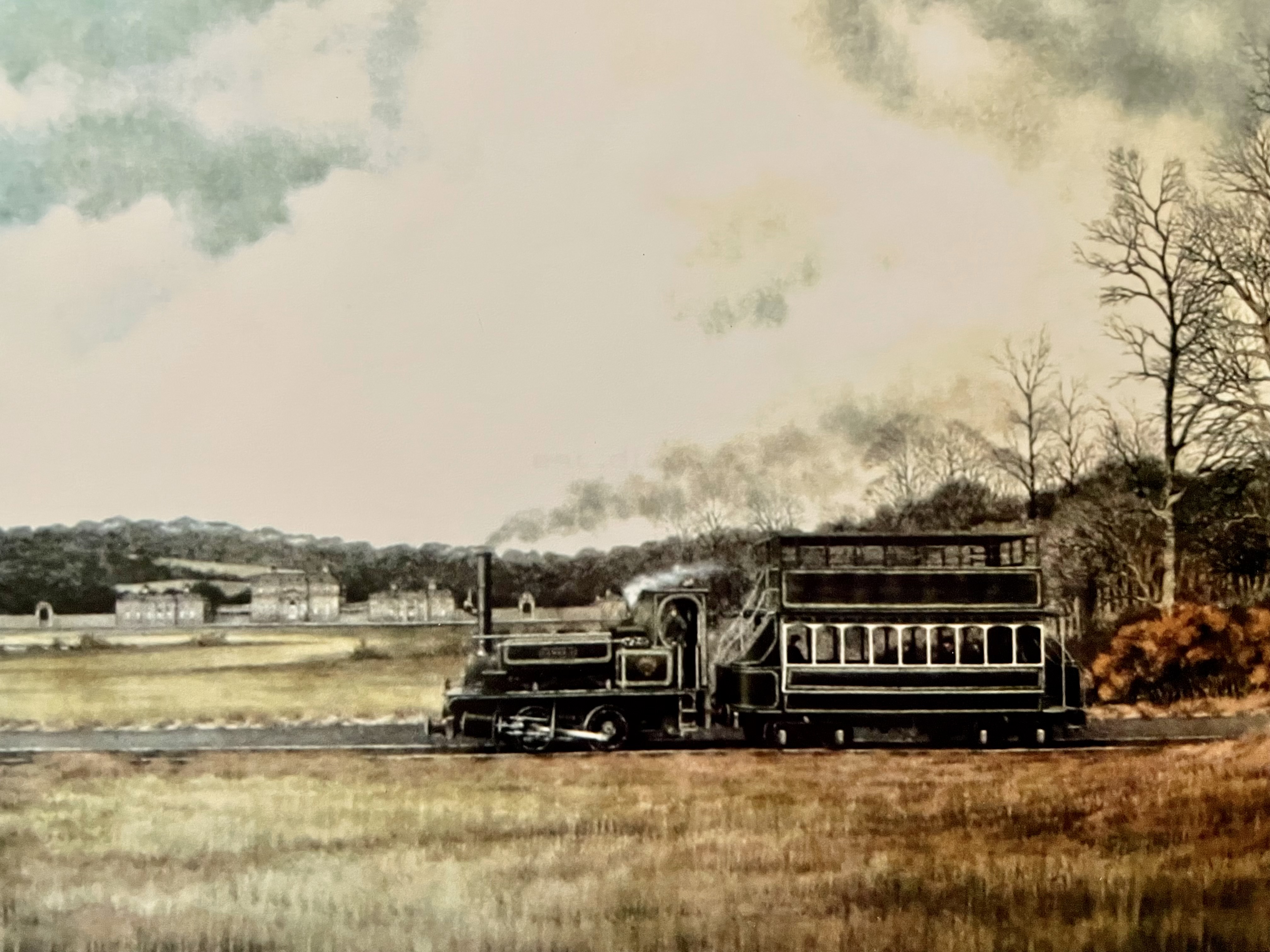
The Cambria passing by Russborough
(At the Fair deals were sealed by the seller spitting on his hand and slapping the buyer’s outstretched hand. The buyer would then counter slap. The ritual went on with friends on both sides encouraging them to agree a price.)
Any comments or questions would be welcome: To contact Jim Corley please click here


Graham mulligan
Hi , was looking to find out some information about James Preston who was killed in 1904 , it mentions there was an inquest in the above story , also looking to find a grave for him?
He was my great, great grandfather.
Tom Malone
Graham,
I have two newspaper items which I can send you if you contact me by email. One refers to the accident and the other is a report on the inquest,
Tom
Claire Brazil
Nice to see that Driver Brazil got his two pence a week pay rise.